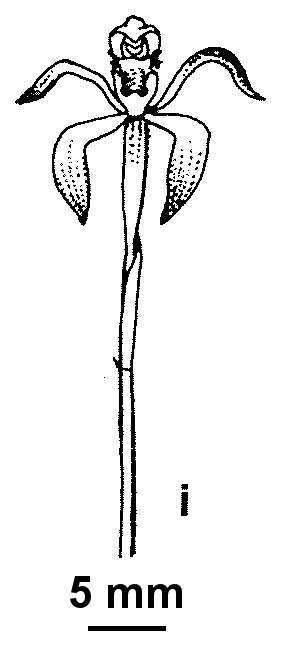Caladenia hildae
Pescott & Nicholls Honey CaladeniaFlowering plant slender, 8–20 cm tall, sparsely hairy. Leaf linear, 6–20 cm long, 1–3 mm wide. Flowers 1–4, yellowish brown to golden brown, darker towards extremities; ovary c. 6 mm long; perianth segments 9–14 mm long, 2.5–3.5 mm wide, acute, both surfaces with stalked and sessile glands (except mid-section of inner surfaces); dorsal sepal hooded, curved at about the middle, embracing column, narrow-elliptic to linear-obovate; lateral sepals and petals spreading, drooping beyond midway, narrow-elliptic to linear-lanceolate, asymmetric, lateral sepals slightly broader than petals. Labellum sessile, obscurely 3-lobed, 6–7 mm long (when flattened), white; margins entire until labellum starts tapering towards the apex, then fringed with calli; calli slender, relatively long, granular-headed (i.e. with rounded minute papillae), white- or yellow-tipped, becoming shorter near to scalloped or toothed apex; apex glandular, entirely dark purple; lamina calli in 4 rows above basal pair, extending from base almost to apex, short and stout, clubbed, heads smooth and white at base of labellum, granular and purple towards tip. Column incurved, narrowly winged at base but expanded above, irregularly banded with reddish or purplish-crimson transverse markings; anther with short point. Flowers Oct.–Nov.
GipP, EGL, EGU, HSF, HNF, MonT, HFE, VAlp. Also NSW. Restricted to high-altitude peppermint forests or snow-gum woodlands of eastern Victoria, on well-structured clay loams, and sometimes locally abundant. Chiefly occurs from the Omeo district eastwards, with an apparently isolated occurrence near Mt Wellington, north of Licola.
Somewhat similar to Caladenia transitoria in colour but closer to C. praecox in morphology. It differs from the latter species in having yellowish brown to golden brown flowers with drooping, heavily glandular, lateral sepals and petals, and in flowering later in the season.
Entwisle, T.J. (1994). Orchidaceae. In: Walsh, N.G.; Entwisle, T.J., Flora of Victoria Vol. 2, Ferns and Allied Plants, Conifers and Monocotyledons, pp. 740–901. Inkata Press, Melbourne.
 Spinning
Spinning

